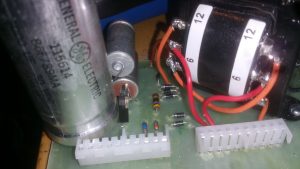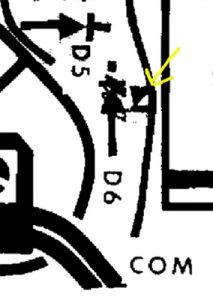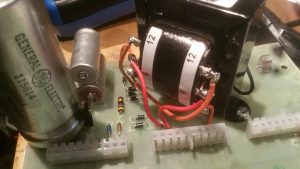Okay so now comes the scary part. The TV Typewriter has its own built in DC power supply, connected to the wall by a line cord soldered into the board. That’s a little intimidating for someone who, until recently, had never built anything electronic in his life! We’re talking live, exposed AC connections. One wrong move under power and.. ouch!
The goal for this first major step in construction is to install the transformer, protection diodes, and any other circuitry related to the power supply. We then want to plug in and switch on and do some voltage tests.
Now, I’m going to confess, I am no electronics engineer. I did not understand the transformer wiring at all. I got some help from friends on vcfed.org with this, as it is not as simple as just connecting the post marked 12V to the PCB point marked 12V. You have to tie certain posts together and then connect them, per the schematic. And prior to that, they had me do some quick voltage tests, to make sure Signal had labelled things correctly in the first place.
Anyway, this is what the completed wiring looks like:
Another problem that tripped me up was the orientation for diode D6. Orientation of diodes here is critical – the diodes provide protection for the system and make sure different voltages aren’t crossed. A mistake here could cause damage to the whole unit!
Complicating matters further, this is one of the (many) examples where the schematic is at odds with the PCB layouts themselves. More experienced eyes than mine looked at the schematics and were convinced the orientation of several diodes were wrong. However, the errata provided after the construction article came out suggested that only D6’s orientation was shown wrong on the PCB silkscreens. Indeed, the scanned copy of the construction guide that I was relying on initially had a correction from the original owner:
After much debate on the forums, I decide to go with the errata and only change the orientation of D6. Although I usually defer to the experts, everything I have read indicates that the PCBs are correct, minus this particular error. So I install all the pieces.
One other note: I took this opportunity to correct a situation I wasn’t comfortable with. In trying to keep the look of the ‘new’ TVT vintage, I had chosen some Mallory 5000uf caps. These are big silver can caps rather than the coloured ‘sausage’ caps common today. The caps I had picked had little metal tabs on them, and to make it fit on the mainframe I had been forced to rig the tabs up with wire and then solder the wires into the board. They looked kinda sketchy. Anyway, I later found some screw top GE 5000uf caps, which I was able to install much more securely. They are silver also and look perfect for the role. So that’s what you see installed in the photo.
With everything connected, I decide to go for a test. I’m more than a little nervous here and go a bit crazy, setting up the unit on the concrete porch outside my (steel) door. I’m going to set the power switch to on and connect the cord behind the door. That way if it goes snap, crackle, pop, I’ve got more than adequate protection! I realize this is of course a little paranoid, but this is my first time messing with something that uses live AC power that I built.
Anyway, after checking and rechecking, I plugged the AC line cord in, braced for explosion. But none comes! I wait a good 5 minutes. Nada! No smoke, no fire! No scary crackling sounds! Woohoo!
Getting more brave, I pull the unit into the house and onto my old tile floor. I plug in again, still standing a few feet away. No problem! Now I man up, and grab my DMM to check voltages. According to the manual, I should have 5V on pins 58 and 59 of the ‘bus’, -5V on pin 57, -12V on pin 56, and +12V at a spot on the mainframe board set aside to provide keyboard power. My results are very close! +5V on 58 and 59 exactly (thank you 7805 voltage regulator!), then -5.45V on pin 57, -12.4V on pin 56, and +13V on the keyboard +12V point. A little out of spec, but given the machine is not under load and that the variance is so small, the power supply is given a clean bill of health! Yahoo!
I know this is kind of a minor thing – after all this is just a power supply at this point, but the fact that I built A POWER SUPPLY THAT DIDN’T BLOW UP is kind of awesome nonetheless! Thank you to all those that helped along the way!



